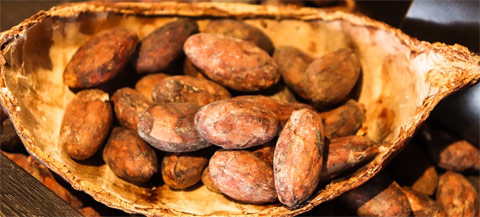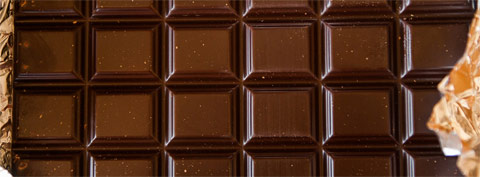History of Chocolate
Our favorite snack, dessert, ice cream and scrumptious treat, chocolate is seen everywhere in thousands of different flavors and foods, a universally loved delight. However, most of us have no idea where chocolate originated from, how it is made and how it became the delicious food we cherish today.
Origins of Chocolate
Chocolate dates back over 4,000 years to the Olmecs and over 2,000 years to the Mayans and Aztecs in Mexico and Central America.
Centuries ago, the Olmecs processed chocolate from the cacao plants into a bitter drink that is believed to have been consumed during ritual ceremonies. The Olmecs passed their chocolate knowledge to the Mayans who treasured the cacao plant and used the plant to make a thick chocolate paste, spiced with hot peppers and honey. Chocolate was consumed mostly on special occasions. The Aztecs took their discovery and love for chocolate to a whole new level, worshipping it as divinity. They used it as an aphrodisiac, to celebrate a momentous occasion and it even became a form of currency for the Aztecs in the 15th century.

Cacao beans were so revered, that for a time it was worth more than gold. Imagine going to a realtor now and putting down an offer to buy a house with a few bags of cacao beans. A few hundred years ago you could have gotten a nice piece of land with a bunch of these beans. Like the Mayans, the Aztecs consumed chocolate with chili peppers, vanilla, and pimento as a bitter beverage. Completely different to the sugary hot chocolate marshmallow drink of today. If you fed your kids a thick, bitter spicy chocolate drink beloved by the Aztecs and Mayans, they would probably spit it away and demand a “real” sugary chocolate.
Chocolate reaching Spain and Europe
It is debated how the Spanish found out about chocolate and who brought it back to Spain, but by the late 16th century, chocolate was soon a beloved treat among the Spanish upper class. The Spanish still consumed chocolate as a beverage, but their palates did not fancy the chili pepper, and so it was replaced with sugar. Once other European countries traveled to Central America and learned about cacao beans and chocolate, they brought this new-found brilliant knowledge and plant back to their prospective countries, and the demand for chocolate started to spread like wildfire. As demand increased, European nations started cacao plantations in their colonies where thousands of slaves labored day in and day out to plant and harvest cacao. Once the supply of chocolate increased through forced labor, chocolate houses started appearing throughout European cities for the wealthy.
Chocolate in the U.S.
Chocolate came to the US through Spanish ships in the mid-17th century, and similar to Europe, chocolate houses for the rich began to pop up in major US cities. By the end of the 18th century, chocolate was a large part of American lives among all classes. Soldiers during the revolutionary war against Britain were even offered chocolate as payment.
From Drinkable to Eatable Chocolate

In the early 1800s, Dutch scientist Coenraad Van Houten figured out how to make a fine chocolate powder by removing the cocoa butter from the roasted beans. In 1828, he then invented the chocolate press to create this powder. The powdered chocolate was easy to mix with water, sugar and other ingredients, thus revolutionizing the way chocolate was consumed. Chocolate creators jumped on this invention known as Dutch Processing and this made chocolate more affordable to the general public.
The first chocolate bar was invented in Bristol, England in 1847 when chocolate maker Joseph Fry added cocoa butter to Van Houten’s cocoa powder creation. This turned the chocolate into a malleable substance, thus allowing Fry to mold his new invention into a bar. Soon after, milk chocolate was invented by Daniel Peter when he added dried milk to cocoa powder. Later the famous Henri Nestle who formed The Nestle Company, marketed, and sold the beloved milk chocolate to the world.
Large, well known chocolate companies started to emerge in the late 19th century. Rudolf Lint, who started the renowned Swiss Lindt company invented the conching machine, which vastly improved the quality of chocolate. By mixing chocolate with air, this gave the end product a divine, smooth consistency.
Chocolate in the US started to be mass produced and enjoyed in the 19th century as well, when Milton Hershey founded Lancaster Caramel Company making chocolate caramels. Hershey soon developed his own recipes for milk chocolate and created the famous Hershey's kisses. In the early 20th century, the company changed its name to Hershey Chocolate and today there is a whole city in Pennsylvania named after the creator where their factories are located.
In the late 19th century, both Cadbury and Mars came into being, and many of the large chocolate brand names started mass producing sweet chocolate bars.
https://pixabay.com/photos/chocolate-swiss-chocolate-candy-1335353/Chocolate Today

Chocolate has evolved immensely from the bitter spiced drinks revered by the ancient Aztecs and Mayans to the wildly diverse flavors and textures we see today. The once worshipped cacao plant, although not seen as divinity in today's world, still plays a large role in celebrations and festivals and is adored by so many around the globe. Mass produced chocolate products are seen in desserts such as chocolate mousse, in birthday parties as chocolate cakes, in breakfast treats such as cereal or muffins, in snacks like chocolate chip cookies and protein bars, and that is just touching the surface of where chocolate is today. Not only is chocolate seen in so many enticing goodies, but chocolate comes in all different forms and flavors. Below are a few of the types of chocolates we see today.
https://pixabay.com/photos/chocolate-white-chocolate-3422350/Milk Chocolate
Invented by Swiss chocolatier Daniel Peter, this consists of powdered milk, cacao powder, condensed milk and sugar.
Dark Chocolate
Dark chocolate is more bitter and contains more than 70% of cacao.
Bitter-sweet Chocolate
Mostly seen in the US, this chocolate is used often in baking and contains 70% cacao and 30% sugar.
Semi-sweet Chocolate
Also seen in the US, it must contain more than 35% chocolate liquor to be classified as semi-sweet chocolate. This is also used in baking but is more multi- purpose and is eaten and used in desserts as well as anything else your gooey chocolate heart desires.
White Chocolate
The sweetest of all the chocolate, and the only chocolate that is not brown, as seen obviously by its name. White chocolate has no cacao in it, just sugar and cocoa butter. There is a hot debate as to whether it should even be considered chocolate since it contains no cacao.
Cocoa Powder
The fine powder created from extracting all the fat from the cocoa butter contains no sugar and is essentially 100% cacao. Cocoa powder is mainly used for baking or making mouth- watering chocolatey drinks.
Ruby Chocolate
Created only recently in 2017 by Belgium chocolatier Barry Callebaut, ruby chocolate, comes from the ruby cocoa bean giving it its distinct ruby red color. Unlike all other chocolate types that either have a sweet or bitter taste, ruby chocolate has a more fruity, sour taste to it.
Fair-Trade Chocolate
In the past, growing and processing cacao plants and beans were all done through slave labor. One would think that now that slavery has been abolished, this forced unpaid labor is no longer in use in the chocolate making process, but sadly with a demand for low priced, mass produced chocolate, cocoa farmers, specifically in West Africa either pay unthinkably low wages or use slave labor on their farms in order to keep their costs low. Most of the slave labor are children that have been trafficked and work long hours under the sun. Unfortunately, since many of the farms where slave labor takes place are small, it is easy for them to hide their illegal business practices out of sight of officials and law enforcement. Cacao farming is also detrimental to the environment when many farmers cut down trees and cause deforestation in an effort to create cacao plantations. In order to stop illegal, corrupt and harmful practices in the making of chocolate, we as consumers should always buy only fair-trade and ethically sourced chocolate, where the company provides certificates. This way hopefully over time we can decrease demand for chocolate that is made using horrendous labor practices.
Sources
- https://www.livescience.com/61754-chocolate-facts.html
- https://www.history.com/topics/ancient-americas/history-of-chocolate
- https://www.chocolate.org/blogs/chocolate-blog/a-brief-history-of-chocolate
- https://www.sfu.ca/geog351fall03/groups-webpages/gp8/history/history.html
- https://www.sfu.ca/geog351fall03/groups-webpages/gp8/darkside/darkside.html
- https://www.britannica.com/topic/Hershey-Chocolate-Corporation
- https://www.simplychocolate.com/learn-different-types-of-chocolate
- https://www.lakechamplainchocolates.com/types-of-chocolate